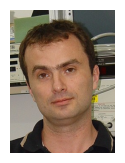Workshop on Organic Electronics
Friday, September 28, 2007
In this workshop the state-of-the-art and recent developments in organic electronic and opto-electronic devices is presented based on experimental, theoretical and computational work. A focus is put on progress in understanding the fundamental electronic properties of organic semiconductors and on modeling techniques.
The detailed workshop program will be announced soon. For more information on this SISPAD companion workshop please contact the workshop organizers directly:
Gregor Meller, TU Vienna, Austria
Ling Li, TU Vienna, Austria
Tibor Grasser, TU Vienna, Austria
09:00 - 09:05 | Welcome Gregor Meller | |
09:05 - 09:40 | Interfaces in Organic Thin-film Transistors G. Horowitz Universite Denis-Diderot (France) | |
09:40 - 10:15 | Charge Transfer at Hybrid Interfaces W.R. Salaneck Linköping University (Sweden) | |
10:15 - 10:50 | Charge Transport Dynamics and Electric Field Effects in Organic Transistors A. Dodabalapur University of Texas at Austin (USA) | |
10:50 - 11:25 | N-type Doping of Organic Molecular Films A. Kahn Princeton University (USA)
| |
11:25 - 11:45 | Coffee | |
11:45 - 12:20 | On the Theoretical Description of Charge Transport in Disordered Organic Materials S. Baranovski Universität Marburg (Germany) | |
12:20 - 12:55 | Utilizing Ions in Organic Electronic Devices G. Malliaras Cornell University (USA) | |
12:55 - 13:30 | Charge Injection and Transport in Tris(8-hydroxyquinoline) Aluminum (Alq3) M.A. Baldo MIT (USA)
| |
13:30 - 15:00 | Lunch | |
15:00 - 15:35 | A. Troisi University of Warwick (UK) | |
15:35 - 16:10 | Novel Approaches in Simulations of Organic Semiconductor Devices Y. Preezant Technion (Israel) | |
16:10 - 16:45 | Macro and Microscopic Modeling of Charge Flows in Disordered Organic Semiconductors L. Li, G. Meller Institute for Microelectronics, TU Wien (Austria)
|
G. Horowitz, Université Denis-Diderot, France

Interfaces in Organic Thin-Film Transistors
All kinds of field-effect transistors include multiple interfaces, at which the major issues of the device converge. More explicitly, these interfaces are that between the semiconductor and the insulator, where the conducting channel forms, and that between the electrodes and the semiconductor, where charges are injected from and extracted to the external circuit. Several ways to improve the quality of these interfaces in organic thin-film transistors (OTFTs) have been recently identified. A most appealing one is the use of self-assembled monolayers (SAMs) that spontaneously form when dipping the substrate into a solution of a reactive molecule. In this presentation, we deal with two specific applications of SAMs in organic transistors. In the first one, the SAM consists of a bifunctional molecule made of a short alkyl chain linked to a conjugated moiety. We show that the latter can serve as the semiconductor of an ultra-thin device where the active layer is reduced to a monomolecular layer, resulting in a device that operates at very low voltage. In the second example, SAMs are deposited on the source and drain electrodes. The idea is to modify the work function of the electrodes in order to promote hole injection into the p-channel. Such adaptive interface can be achieved by adjusting the dipole moment of the molecule used in the SAM. By measuring the contact resistance, we show that hole injection is enhanced when the dipole moment is oriented from the semiconductor to the electrode, while injection is hindered when the dipole is oriented from the electrode to the semiconductor. These results are interpreted in terms of band alignment at the metal-semiconductor interface.
Gilles Horowitz received a MS degree in solid state physics at the University Paris 7 in 1973. He was hired as Senior Scientist (“Chargé de Recherche”) by the “Centre National de la Recherche Scientifique” (CNRS) in 1976. He defended his PhD thesis in solid state physics at the University Paris 7 in 1981. In 1982, he moved to the “Laboratoire des Matériaux Moléculaires” in Thiais, near Paris, and in 1989 he started a research program in organic electronics that led the same year to the realization of the first organic transistor made of a conjugated oligomer. He joined the University Paris Diderot in 2000 and was appointed professor in 2005. He currently leads a research group of four permanent personnel and three PhD students. His current research themes include the modification of organic electronic device interfaces with self-assembled monolayers and the modeling of organic thin-film transistors. He has recently launched a program on organic-based biosensors. He is the author or coauthor of nearly 200 publications and communications in international journals and conference proceedings.top
W. R. Salaneck, Linköping University, Sweden

Charge Transfer at Hybrid Interfaces
Charge transfer at interfaces, both hybrid and organic-organic, involving materials for modern molecular electronics, are determining for device performance in future organic electronics. Both static and dynamic effects are important in this context. Mainly, static integer-charge transfer at hybrid interfaces, which determines barriers to charge injection, will be described. The electronic interfacial alignment parameters are displayed, and the control of such alignment using adsorbed mono-molecular layers at the interface is illustrated. Second, briefly, ultra-fast charge transfer, as studied by the use of resonant core-level excitation and decay measurements, will be described. These measurements are initiated by soft X-ray absorption to specific initially unoccupied states on the molecules, creating a short-lived core excited state. Dynamic charge transfer events which occur on the time scale of the C(1s) core-hole lifetime (6 fs) may be addressed.
W. R. (Bill) Salaneck is the professor of Surface Physics and Chemistry in Linköping. His research has focused upon studies of the electronic and chemical structure of conjugated polymers, their surfaces, and the doping of conjugated polymers to produce electrically conducting organic polymers. Over the most recent decade, his research has centered upon polymer materials and other organic molecules, and especially hybrid interfaces that occur within molecular and polymer electronics. He has organized ten major international conferences and workshops on conjugated and conducting polymers, including one Nobel Symposium. He is a founding member of the Center for Advanced Molecular Materials, focused on the Max Laboratory, for Synchrotron Radiation Studies in Lund, Sweden. He has published over 350 scientific articles and patents. He is a Fellow of the American Physical Society. In 2003, he shared the René Descartes Prize of the European Union, with Prof. Sir R. H. Friend, University of Cambridge, UK, and Prof. J. L. Brédas, Georgia Institute of Technology, USA, and three European Industries , COVION(Germany), Philips(NLD), and CDT(UK). Since 2004, he is a Vicerektor of Linköping University.top
A. Dodabalapur, University of Texas at Austin, USA

Charge Transport Dynamics and Electric Field Effects in Organic Transistors
Thin films of ordered organic semiconductors are being investigated as channel materials in field-effect transistors for a variety of applications. A detailed understanding of charge transport in such organic thin-film semiconductors used in field-effect transistors is of fundamental interest and is also essential to improve device performance. Most experimental studies performed so far have emphasized measurement and interpretation of temperature-dependent field-effect mobility. In this presentation, we report temperature and electric-field dependence of field-effect mobility in polycrystalline pentacene thin-film transistors of scaled channel geometries. We will also discuss the scaling of organic transistors to small channel lengths. The dynamic characteristics of polymer and organic transistors will be described along with how we can extract drift mobility and velocities from such data.
Ananth Dodabalapur received his bachelors degree from the Indian Institute of Technology, Madras (Chennai) in 1985, and M.S. and Ph.D. degrees in Electrical Engineering from The University of Texas at Austin in 1987 and 1990 respectively. Between 1990 and 2001 he was with Bell Laboratories, NJ. Since 1992 he has investigated various aspects of the physics and technology of organic and polymer semiconductor devices. He has published over 100 articles in refereed journals and has 25 issued US patents. He is a co-recipient of the 2002 National award for team innovation of the American Chemical Society, and a co-recipient of an R&D 100 award for 2001. Since September 2001, he is with The University of Texas at Austin and is the Ashley H Priddy Centennial Professorship in Engineering, and also holds the June and Gene Gillis Endowed Faculty Fellowship. His present research includes organic transistors, nano-scale organic devices, chemical and biological sensors, and organic-based circuits. In 2003, he co-founded OrganicID, a company that is investigating using printable polymer electronics to fabricate low-cost RFID tags for the 13.56 MHz frequency. He is also a visiting professor at the Institute of Materials Research and Engineering (IMRE) Singapore.top
A. Kahn, Princeton University, USA

N-type Doping of Organic Molecular Films
N-type doping of organic materials is difficult because of the low electron affinity (~1.5 – 2.5 eV) of most electron transport materials (ETM) of interest. Dopants must have low ionization energy to transfer an electron to lowest unoccupied molecular orbital (LUMO) of the host, and are thus inherently unstable. Alkali cations are mobile and diffuses through the organic layer. Their small size leads to a fairly tightly bond cation-anion pair with the host molecule, resulting in strong electron localization. Larger, less mobile donors are therefore being pursued. We report here on the use of the strongly reducing molecule bis(cyclopentadienyl)-cobalt(II) (cobaltocene, CoCp2) (ionization energy = 4.0 eV) to n-dope an important ETM, a tris(thieno)hexaazaphenylylene derivative (THAP) [1]. UPS, inverse photoemission, ion scattering, X-ray photoemission and I-V measurements are used to characterize the energetics and transport properties of the doped system. We also describe on-going work using the even stronger reducing molecular agent decamethyl cobaltocene to n-dope phthalocyanines and pentacene.
Antoine Kahn received his Ph.D. in Electrical Engineering and Computer Science from Princeton University in 1978. He joined the Princeton faculty in 1979, and was promoted to the rank of Associate Professor in 1985 and Full Professor in 1991. His research is in the field of semiconductor surfaces and interfaces. Over the past twelve years, he and his group focused on the structural, electronic and chemical properties of surfaces and interfaces of organic molecular and polymer films, and the physics of molecular level alignment across interfaces. He has published over 260 regular and review articles. He is a Fellow of the AVS (1999) and APS (2002).top
S. Baranovski, Universität Marburg, Germany

On Theoretical Description of Charge Transport in Disordered Organic Materials
It has been well established that hopping of charge carriers via localized states is in many cases the dominant transport mechanism in disordered organic solids, such as molecularly doped polymers, conjugated polymers, and organic glasses. Nevertheless there is no agreement among researchers with respect to the appropriate theoretical description of the very key dependences of the carrier mobility u on the concentration of localized states N, on the concentration of charge carriers n, on temperature T, and on the applied electric field F in organic materials in the hopping regime. Modern concepts developed in the recent years to describe the dependences u (N, n, T, F) will be analyzed in the talk and their ability to describe experimental data will be discussed.
Professor Sergei Baranovski received his Ph.D. (1981) in Theoretical Physics from Ioffe Physical-Technical Institute of the Russian Academy of Sciences in St. Petersburg, where he worked as a senior researcher till 1990. Since 1990 he has been working at the Philipps University Marburg, Germany where he got Habilitation in Theoretical Physics (1995). His research interests are devoted to optical properties of semiconductor quantum structures, to charge transport and optical properties of amorphous inorganic semiconductors, and to transport properties of organic disordered solids. He is the author and co-author of more than 160 publications in international journals and the editor of the book “Charge Transport in Disordered Solids with Applications in Electronics” published by Wiley in 2006.top
G. Malliaras, Cornell University, USA

Utilizing Ions in Organic Electronic Devices
Dramatic advances have been achieved in the performance of organic electronic devices during the last fifteen years. Several traditional devices, such as light emitting diodes, transistors, and solar cells, can now be made using pi-conjugated organic materials as the semiconductor. This is of interest because of the potential for low-cost fabrication, and for the exciting science organic materials bring to the table. However, as in traditional (silicon) electronics, the operation of these devices relies predominantly on electronic carriers, while ions are neglected. I will draw on two examples to illustrate the advantages that can be gained (and the penalties that must be paid) when, in addition to electronic carriers, ions are also employed. The first one is electroluminescent devices based on ionic transition metal complexes. These materials, studied for years by electrochemists and spectroscopists in solution, can now yield efficient solid-state electroluminescent devices that are considered for display and lighting applications. Materials issues that need to be addressed for these devices to succeed in applications will be discussed, and emphasis will be given on modeling and understanding the device physics. The second example is electrochemical transistors based on conducting polymers. These devices act as converters between ionic and electronic current, providing a powerful interface between the worlds of biology and electronics. Their applications in sensors will be discussed, with emphasis on understanding device operation.
George Malliaras is the Lester B. Knight Director of the Cornell NanoScale Facility, and an Associate Professor in the Department of Materials Science and Engineering at Cornell University. Prof. Malliaras received a BS in Physics from the Aristotle University (Greece), and a PhD, cum laude, in Mathematics and Physical Sciences from the University of Groningen (the Netherlands). He joined Cornell University in 1998 after a two year postdoc at the IBM Almaden Research Center. Prof. Malliaras is the recipient of the NSF Young Investigator Award, the DuPont Young Professor Grant, and a Cornell College of Engineering Teaching Award. He serves on the board of directors of Infotonics, a MEMS fabrication facility designed to provide a rapid pathway to commercialization, is the chairman of the editorial board of the Journal of Materials Chemistry, and serves on the editorial board of Sensors. Prof. Malliaras' research interests span several aspects of organic electronics, including structure and morphology of organic thin films, their processing and patterning, charge transport and injection in organic semiconductors, device physics, and applications of organic devices in biosensors.top
M. Baldo, M.I.T., USA

Charge Injection and Transport in Tris(8-hydroxyquinoline) Aluminum (Alq3)
Tris(8-hydroxyquinoline) aluminum (Alq3) is the archetypal small molecular weight amorphous semiconductor. There is a substantial amount of data describing its charge transport characteristics as a function of thickness, injection contact, temperature and electric field. We briefly summarize this data and focus on two issues: charge injection into Alq3 and the electric field dependence of charge carrier mobility in Alq3. We present an analytic description of mobility by considering non-equilibrium carrier distributions within a percolation framework.
Marc Baldo is an Associate Professor in the Electrical Engineering and Computer Science Department at MIT. He received his B.Eng. (Electrical Engineering) from the University of Sydney in 1995 with first class honors and university medal, and his M.A. and Ph.D. from Princeton in 1998 and 2001, respectively. He joined MIT in 2002. His Ph.D. work concentrated on electronic processes in organic materials and was obtained under the supervision of Stephen Forrest at Princeton. Research interests include electrical and exciton transport in organic materials, energy transfer, metal-organic contacts, heterogeneous integration of biological materials, and mechanical transistors. He is a member of the American Physical Society, the Materials Research Society and the IEEE, where he serves on the Organic Electronics Technical Committee.top
A. Troisi, University of Warwick, UK

Charge Transport Regime in Crystalline Organic Semiconductors: Predicting the Absolute Temperature Dependent Charge Mobility
I propose a computational protocol to predict the absolute mobility of molecular semiconductors without adjustable parameters. The system dependent parameters are computed using a combination of classical molecular dynamics simulations and quantum chemical methods. The model used to connect the computable quantities with the observable temperature dependent mobility takes into account the effects of molecular reorganization energy and the fluctuation of the transfer integral due to thermal motions. The absolute value of the hole mobility, computed for the case of rubrene, is in excellent agreement with the experiments. The possibility of using computational chemistry methods to improve the theoretical models of charge transfer will be discussed in some detail. The predictive capabilities of the model presented in this work will be further validated considering the recent THz spectroscopy measurements performed by R. van Laarhoven in Eindhoven.
Alessandro Troisi received his PhD in Physical Chemistry (2001) from the University of Bologna with a thesis on the charge transfer reactions in condensed phases. He became interested in the field of Molecular Electronic since his postdoctoral period at the Northwestern University (2002-2003) in Mark Ratner’s group, where he worked on the description of the electron transport through flexible molecules and developed a model for inelastic tunneling spectroscopy. In 2004-2005 I was a research fellow at the University of Bologna where he studied the charge transport mechanism in organic solid crystals. He joined the Department of Chemistry of the University of Warwick in October 2005 as a Research Council UK Fellow and Assistant Professor. He currently works on organic semiconductors, quantum dynamics and theory of molecular self-assembly.top
Y. Preezant, Technion, Israel

Novel Approaches in Simulations of Organic Semiconductor Devices
We present new approaches in simulations of organic semiconductor devices. We present statistical modified mean-media approach (MMMA) and transport path distribution approach. Within MMMA approach we succeed to reproduce effective heating effect predicted by numerical experiments on hopping transport on the manifold of energetically disordered hopping sites. Those experiments predict redistribution in carriers’ population under applied field. The redistribution of the carriers` population may be described, as elevation of effective temperature of the population while the temperature of the phononic bath remains low. Using MMMA approach we reveal the dependence of recombination on field and charge carriers concentrations. Transport path distribution (TPD) approach used for description and analysis of current transients in organic semiconductor devices. We present analysis of experimental results using this method.
Yevgeni Preezant was born at 1973. He had got B. A. in Physics at 2000 from the Technion (Israel Institute of Technology) and M.A. from Electrical Engineering Department at 2004. Recently he is a doctoral fellow in polymer semiconductor group of Prof. Nir Tessler in the Technion. Research interest of Mr. Yevgeni Preezant include both experimental ,theoretical and simulation aspects of polymer semiconductors field.top
